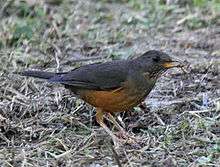Olive thrush
| Olive thrush | |
|---|---|
 | |
| Adult of the nominate race | |
| | |
| Song recorded in KwaZulu-Natal, South Africa | |
| Scientific classification | |
| Kingdom: | Animalia |
| Phylum: | Chordata |
| Class: | Aves |
| Order: | Passeriformes |
| Family: | Turdidae |
| Genus: | Turdus |
| Species: | T. olivaceus |
| Binomial name | |
| Turdus olivaceus Linnaeus, 1766 | |
The olive thrush (Turdus olivaceus) is, in its range, one of the most common members of the thrush family (Turdidae). It occurs in east African highlands from Tanzania and Zimbabwe in the north to the Cape of Good Hope in south. It is a bird of forest and woodland, but has locally adapted to parks and large gardens in suburban areas.
It can reach a length of 24 cm and a mass of at least 101 grams. The tail and the upperparts are coloured dull olive brown. The belly is white and the rest of the underparts have an orange hue. The throat is speckled with white spots. It can be found in evergreen forests, parks, and gardens. Its diet consists of earthworms, insects, snails, fruits, and spiders.
In southern Africa alone, there are five subspecies which differ mainly in the relative amounts of white, orange and brown on the underparts: T. o. swynnertoni, T. o. transvaalensis, T. o. olivaceus, T. o. pondonensis, and T. o. culminans. The Karoo thrush (Turdus smithi), the Somali thrush (Turdus ludoviciae) and the Taita thrush (Turdus helleri) are variously included as subspecies of the olive thrush or considered separate species, of which the last is critically endangered. Additionally, the taxa from the northern part of its range are sometimes regarded as one (Northern olive thrush or mountain thrush, T. abyssinicus) or several separate species (Abyssinian thrush, T. abyssinicus, and Usambara thrush, T. roehli).
The female builds a cup nest, typically 2 to 9 m above the ground in a tree or hedge. The 1–3 (usually 2) eggs are incubated solely by the female for 14–15 days to hatching, and the chicks fledge in another 16 days.
The male's song is a mix of fluted, whistled and trilled phrases, which varies geographically. It occasionally mimics other birds.
References
- ↑ BirdLife International (2012). "Turdus olivaceus". IUCN Red List of Threatened Species. Version 2013.2. International Union for Conservation of Nature. Retrieved 26 November 2013.
- Bo T Bonnevie, The biology of suburban Olive Thrushes (Turdus olivaceus olivaceus) in the Eastern Cape, South Africa (2005). M.Sc. thesis, Rhodes University, South Africa
- Clement and Hathaway, Thrushes ISBN 0-7136-3940-7
- Sinclair, Hockey and Tarboton, SASOL Birds of Southern Africa, ISBN 1-86872-721-1
| Wikimedia Commons has media related to Turdus olivaceus. |
External links
- Olive thrush - Species text in The Atlas of Southern African Birds.
